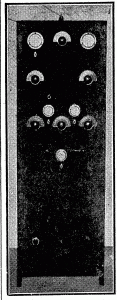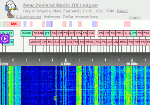A GRATUITOUS SERVICE
From the “Otago Daily Times”, 3 August 1935, page 22.
FILLING THE SILENT HOURS
WORK OF THE B STATIONS
To the enthusiastic band of amateurs who have established and now operate what are known as the “B” class stations, every listener owes a debt of gratitude. Filling in as they do the silent hours of the “A” organisations, these stations are performing a service in the broadcasting world which cannot be estimated too highly. Since 4ZL, 4ZB, 4ZO, and 4ZM came on the air, set owners are no longer at a loss to find entertainment when the YA studios are silent, for at all times one or other of these little stations is ready to step into the breach and provide a programme. When one considers that the owners depend entirely on voluntary contributions to keep their stations going, and receive not one penny either by subsidy or from listeners’ license fees, one cannot but wonder how they manage to send out programmes of such uniformly high standard entirely gratuitously. In addition many events of public interest have been broadcast by these stations with complete success.
STATION 4ZL
A station with an excellent record of transmissions is 4ZL, owned by the Radio Service, Ltd., which, although it has been on the air only a little over 12 months, is well and favourably known to most listeners in Otago. After the Exhibition permission was obtained for 4AK to work phone on the broadcast band and a few tests were made. These turned out so well that when the Radio Service, Ltd., was formed an application was made for a transmitting license for this company. The company was allotted the call sign 4ZL, and it immediately commenced to make a good broadcast transmitter. This was completed in June, 1928, and the station was put on the air. Difficulties were met at first, but one by one these were overcome, and although the station is only a low powered one it has had several reports over good distance. It has been received in the middle of Australia at 6 p.m. in daylight, and also in Los Angeles and San Diego. In recent years the station, with the installation of new equipment, has been put on higher power, and some extraordinary, details of reception from every corner of the world have been received.
The manager and engineer-in-chief of the station is Mr Lawlor A. Shiel, one of the foremost authorities on radio construction and practice in New Zealand, and a pioneer of the wireless movement in Otago.
RADIO 4ZM
In September, 1927, the Post and Telegraph Department allotted the call sign 4ZM to Mr J. M’Kewen at 418 Anderson’s Bay road, Dunedin, and about one month after this date the station, with Mr J. Stone as operator, commenced activities. In connection with the granting of the license, it is interesting to note that one of the conditions was that the station must not interfere with 4YA. That this possibility could even have been contemplated may give the reader some idea of the unformed state of the broadcasting art at this period. In common with most “B” stations, 4ZM, from the day of its inception, experienced many changes, both in design and location. In September, 1929, the owner, for business reasons, transferred the station to the premises of Messrs Chas. Begg and Co., in Princes street. Here its broadcast attracted an ever increasing number of listeners, ‘perhaps the most appreciated being the programme of popular recordings broadcast each Sunday evening. 4ZM continued a regular schedule of transmissions from the same location until September, 1932, when Messrs M’Cracken and Walls acquired from the original owner, Mr M’Kewen, the whole of the plant and accessories comprising the station. A transfer of the station license was granted by the Post and Telegraph Department, and a new chapter in the life of Radio 4ZM, Dunedin, had begun. The transmitter at 4ZM remained in its original condition for some time, but coincident with the appointment of Mr J. P. Pickerill as station engineer it was decided to dismantle the old plant entirely and build a new transmitter of as modern a design as possible. A small stand-by transmitter was placed in commission to carry on while the main constructional work was being completed, and in due course a new 4ZM commenced broadcasting. This transmitter has remained practically unchanged until the present time, and has given splendid service. Briefly, the transmitter is of the master oscillator power amplifier type, using pushpull stages throughout, with final stage high level modulation. This method of modulation has been found to be extremely efficient, much more so than the use of Heising modulation, or the use of linear stages in the radio frequency amplifiers, and very favourable comment has always been received on the quality of the transmissions from 4ZM since this method was used. However, the radio art is always advancing, and once more it has been decided to take advantage of many new developments: in broadcast transmitter technique, and to this end a new high fidelity transmitter will be heard from 4ZM as soon as the constructional work on the new studios and control rooms is completed. Although the power of the station cannot, owing to Government regulations, be increased, both the modulation percentage and the range of musical frequencies transmitted will be much greater than heretofore. The whole work of designing and building the transmitters and associated equipment such a relay amplifiers, etc, has been done in the workshops at 4ZM under the supervision of the station engineer, and has always been found to perform as satisfactorily as completely built imported equipment. It is hoped to have the new station on the air early in September, and reports from listeners with high fidelity receivers will be awaited with much interest by the technical staff at 4ZM. It will be of interest to listeners to learn that from September 1 the station will operate on a frequency of 1010 kilocycles instead of 1050 kilocycles as at present.
STATION 4Z0
Another station that has provided efficient service for listeners is 4Z0 (which is maintained by Messrs Barnett’s Radio Supplies, Ltd.,) and, as is the case with Dunedin’s other B stations, receives no financial assistance from any outside source. The transmitting unit shown in the illustration is the new plant which has just been completed in the company’s workshop by Mr Frank Barnett, jun., the operator, for use in the station. The unit includes all the major stages for modulation and transmission in a very compact form, and is built in five sections; which are easily removed from the unit in case of breakdown. Commencing at the bottom they are as follows:—(1) Power supplies and rectifiers for all stages and overload protection device (2) Filter chokes and condensers for smoothing of rectified alternating current from (1) ; (3) Modulation stage, comprising two stages of pushpull audio class AB, capable of driving the final amplifier transmitter stage to a high level of modulation; (4) Pushpull, electron coupled oscillator and push-pull buffer amplifier stage where the transmitting energy is generated, controlled, tuned, and amplified for supplying the final modulated amplifier with energy; (5) Push-pull, class C modulated radio, frequency amplifier stage and antennae coupling and tuning unit. The transmitting unit is completely A.C. operated from the 230-volt mains, no batteries being used whatever. The power is 25 watts. Some of the new equipment is not quite ready, such as microphones and microphone amplifiers1 but these will be finished in a few days, and will be brought into operation immediately they are completed.

Listeners have reported reception of 4Z0 from as far away as Brogo Brogo and Woolongong in New South Wales, and from Whangarei, North Auckland, to Half Moon Bay, Stewart Island, and good reports have been received. The hours of operation are:-Mondays, 12 noon to 1 p.m., 2 to 3 p.m., 5 to 6 p.m., and 8 to 11 p.m.; Tuesdays, Wednesdays and Thursdays, 12 noon to 1 p.m., 2 to 3 p.m., and 5 to 6 p.m.; Fridays, 12 noon to 1 p.m., 2 to 3 p.m., 5 to 6 p.m., and 7 to 11 p.m.; Saturdays, 12 noon to 1 p.m.; Sundays, silent. The wavelength of the station is at present 1050 kilocycles, but from September 1 it will operate on a frequency of 1010 kilocycles to fall in with the new allocations of wavelengths as arranged between Australia and New Zealand, which will come into force on that date. The new announcer at 4Z0 is Mr Owen M’Connachie, and the assistant announcers are Mr J. B. M’Connell and Mr J. Anderson.
STATION 4ZB
To 4ZB, the efficient little station of the Otago Radio Association, belongs the honour of being the veteran of Dunedin’s B stations. It was as far back a 1922 when, following the formation of the association, the station received its license and commenced operations. In the early days of the station the association had an uphill struggle, but despite all difficulties it managed to carry on, and to-day its evening session every Wednesday is as eagerly looked forward to by all juvenile listeners as its Sunday morning transmissions are welcomed by those who wish to tune in to something besides a church service.



